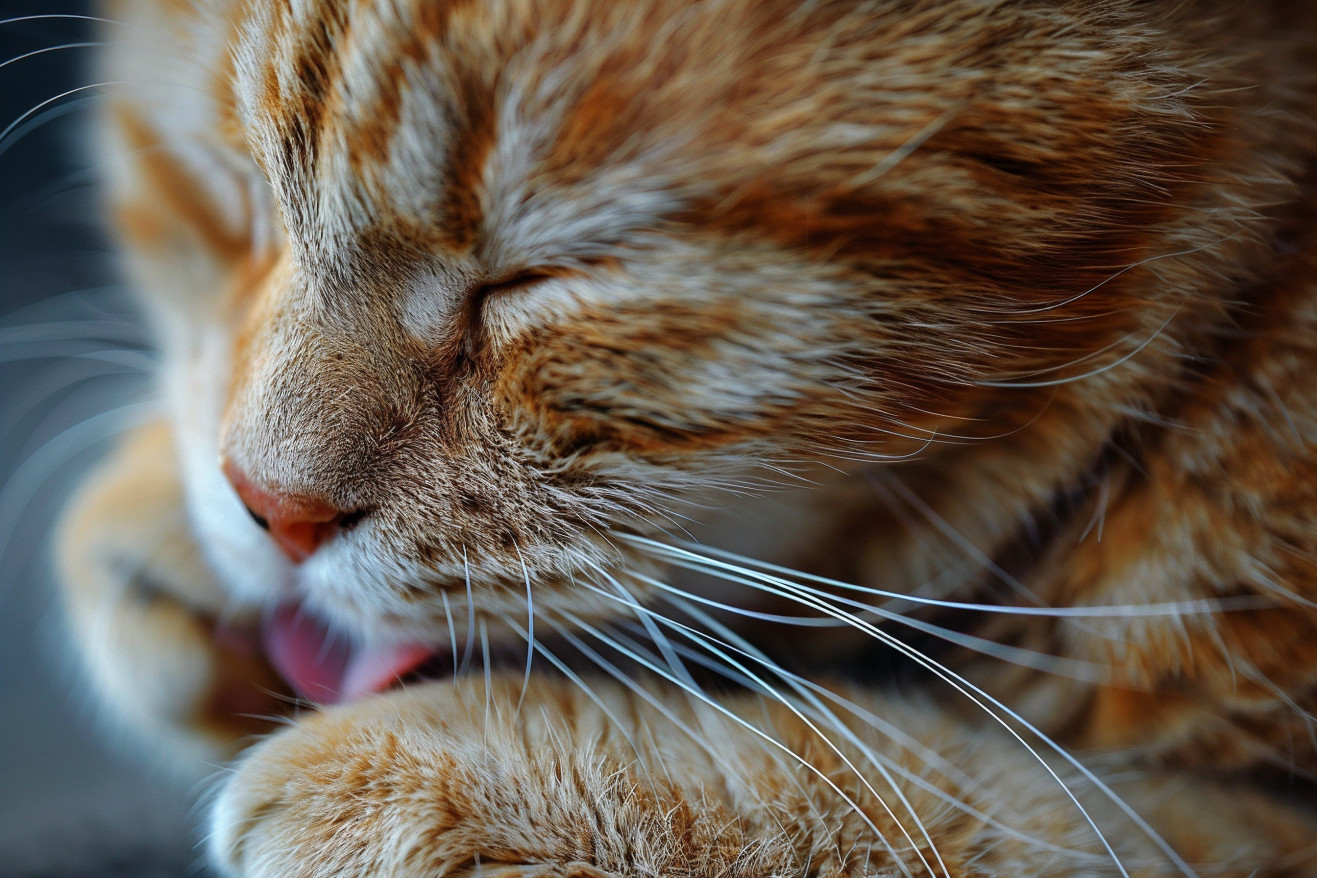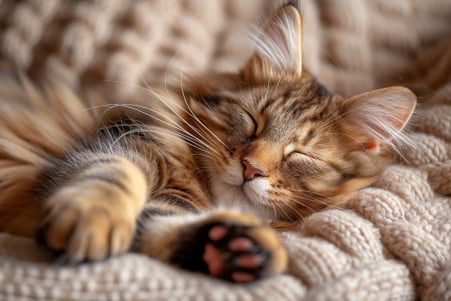Why Cats Have Rough Tongues: An Evolutionary Wonder
27 March 2024 • Updated 27 March 2024

Have you ever wondered why your cat's tongue feels like sandpaper when they lick you? It turns out that the feline tongue is covered with tiny, sharp, backward-facing spines called papillae. The papillae give the tongue a rough texture that helps cats groom themselves by acting like a comb to remove loose fur, dirt, and other debris from their fur.
To learn more about the special roughness and clever design of the feline tongue, let's take a look at scientific research on the biological makeup, evolutionary history, and functional purposes of this amazing organ. This work shows how the papillae's structure helps with grooming, drinking, and even protecting against bacteria. By exploring these findings, you'll come away with a deeper understanding of the complex evolutionary adaptations that have been shaped by nature in our feline friends.
Why do cats have rough tongues?
Anatomy and Structure: Exploring the Cat's Tongue
A cat's tongue is a remarkable organ covered in hundreds of tiny, hook-shaped papillae made of keratin, according to Hill's Pet. These papillae are arranged in a backward-facing direction to aid in grooming and cleaning the cat's fur. The tongue features different types of papillae, including filiform papillae which are rigid and spiny, as well as fungiform, foliate, and vallate papillae that contain taste buds, as noted by The Tiniest Tiger.
The papillae vary in size and shape depending on the cat breed and species. For example, larger wild cats like lions have larger papillae compared to domestic cats, Kritter Kommunity explains. The tongue's flexibility and specialized arrangement of these papillae structures allow cats to groom their fur effectively. The rigid filiform papillae act like tiny combs to remove loose hair, dirt, and debris from the coat.
The unique anatomy of the cat's tongue, with its array of specialized papillae, is an evolutionary adaptation that aids in efficient self-grooming.
Grooming Experts: Why Cats Have Rough Tongues
The roughness of the cat's tongue is ideally suited for grooming, says Ars Technica, because the papillae are able to penetrate the fur and make contact with the skin, which helps to spread saliva and natural oils over the fur.
In addition, as the cat licks, the papillae curve backward and draw saliva up from the skin, which then evaporates to help cool the cat, according to PetMD. This grooming action is important for removing loose hair, dirt, and parasites and for spreading the cat's natural oils over the fur to keep it healthy and shiny.
That said, long-haired cat breeds, such as Persians, may have trouble grooming themselves effectively because of their thick, dense fur, says AAHA. The papillae on the tongue may not be able to penetrate their long fur to reach the skin. In these cases, providing the right grooming supplies can help these cats keep their fur clean and healthy.
Hunting and Feeding: Why Cats Have Rough Tongues
The roughness of a cat's tongue is essential to their hunting and feeding habits. According to Wonderopolis, the papillae on the tongue help cats hold onto and tear apart their prey during a hunt. The tiny, hook-like structures also make it easier to remove meat from bones, which helps cats get the most out of the food they catch.
In addition to hunting, a cat's rough tongue acts as a filter, separating food from waste and other unwanted materials as they eat, according to The Village Vets. This ensures that they're only ingesting the most nutritious parts of their meal.
The roughness of the tongue also plays a role in some important social behaviors in cats. According to The Village Vets, the papillae are a key part of the process of allogrooming, which is when cats groom each other as a way to bond. This communal grooming helps to build and maintain social bonds within a cat's community.
The papillae's structure, which is consistent across all species of cats, is an evolutionary response to the cat's status as an obligate carnivore. According to Daily Paws, the papillae's ability to hold onto and tear apart meat helps cats get the most energy and nutrients from their prey, which is essential to their survival.
Evolutionary Adaptations: Where the Rough Tongue Comes From
The roughness of a cat's tongue is an evolutionary adaptation that has several important purposes, according to The Tiniest Tiger. Since cats are solitary hunters, the papillae on their tongue help to reduce their scent, which makes it easier for them to sneak up on their prey. The hook-like shape of the papillae also helps cats grasp and pull meat off the bones of their prey, which helps them get the most energy and nutrients from their food, according to Daily Paws.
In addition to hunting and eating, the roughness of a cat's tongue is also important for temperature regulation. A study in the Proceedings of the National Academy of Sciences showed that the U-shaped cavities in the papillae act as a wick, pulling saliva up from the tongue where it can evaporate and help cool the cat down as it grooms. This cooling mechanism is found in all cats, from domestic cats to large cats like lions and tigers.
The rough, papillae-covered tongue is a characteristic that all cats share and is an example of the evolutionary adaptations that have helped cats become successful hunters and survivors. Learning about the origins and purposes of this unique feature can help you better understand and admire the clever design of your feline friends.
Oral Health and Hygiene: How to Make Sure Your Cat's Tongue Stays Healthy
A cat's tongue can offer valuable clues about their overall health, according to PetMD, so any changes in the tongue's appearance or function should be brought to the attention of a veterinarian. For example, the Merck Veterinary Manual explains that glossitis, or inflammation of the tongue, can be caused by infections, irritants, or foreign bodies stuck under the tongue. However, other than causing drooling and a reluctance to eat, glossitis is usually a sign of an underlying health issue.
The Merck Veterinary Manual also notes that thermal, chemical, or electrical burns to the mouth can be very dangerous. In addition to causing a reluctance to eat or drink, mouth burns can lead to painful sores and inflammation that are prone to infection. If you suspect your cat has a mouth burn, seek veterinary care immediately.
In addition to regular dental exams and cleanings, which can help ensure that a cat's tongue and mouth stay healthy, regular grooming can also help maintain a cat's overall health. For example, according to Cats.org.uk, cats with long or thick coats that have trouble grooming themselves can benefit from regular brushing and combing to help keep their tongues and fur in good shape.
Conclusion: The Cat's Tongue Is an Evolutionary Marvel
The cat's tongue is a marvel of evolutionary adaptation. The papillae that give the tongue its rough texture enable the cat to groom, hunt, and regulate its body temperature. This understanding of the cat's tongue anatomy is a testament to the power of natural selection and evolution.
Future studies will likely continue to reveal more about the cat's tongue and the ways it has evolved to meet the cat's needs. In the meantime, proper care and grooming will help ensure that your cat's tongue stays healthy and functional.


